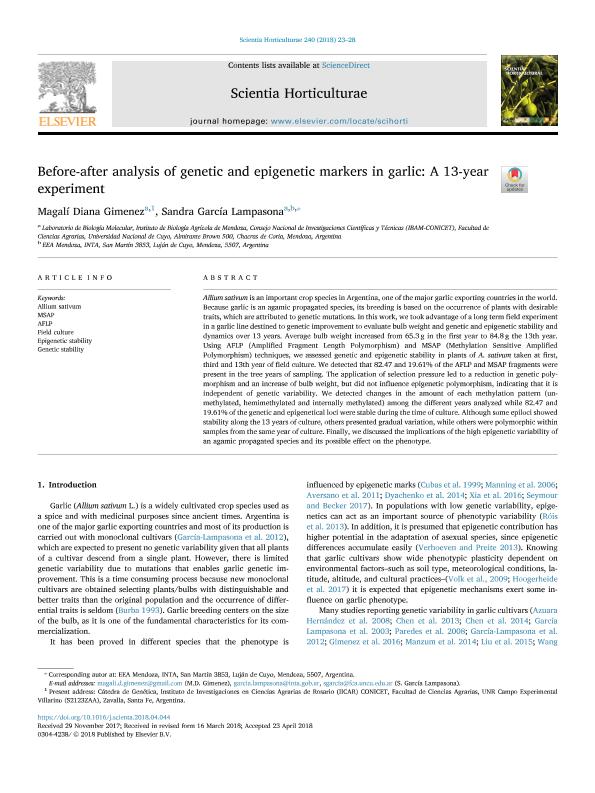Mostrar el registro sencillo del ítem
dc.contributor.author
Giménez, Magalí Diana

dc.contributor.author
Garcia Lampasona, Sandra Claudia

dc.date.available
2019-11-28T22:25:58Z
dc.date.issued
2018-10
dc.identifier.citation
Giménez, Magalí Diana; Garcia Lampasona, Sandra Claudia; Before-after analysis of genetic and epigenetic markers in garlic: A 13-year experiment; Elsevier Science; Scientia Horticulturae; 240; 10-2018; 23-28
dc.identifier.issn
0304-4238
dc.identifier.uri
http://hdl.handle.net/11336/90857
dc.description.abstract
Allium sativum is an important crop species in Argentina, one of the major garlic exporting countries in the world. Because garlic is an agamic propagated species, its breeding is based on the occurrence of plants with desirable traits, which are attributed to genetic mutations. In this work, we took advantage of a long term field experiment in a garlic line destined to genetic improvement to evaluate bulb weight and genetic and epigenetic stability and dynamics over 13 years. Average bulb weight increased from 65.3 g in the first year to 84.8 g the 13th year. Using AFLP (Amplified Fragment Length Polymorphism) and MSAP (Methylation Sensitive Amplified Polymorphism) techniques, we assessed genetic and epigenetic stability in plants of A. sativum taken at first, third and 13th year of field culture. We detected that 82.47 and 19.61% of the AFLP and MSAP fragments were present in the tree years of sampling. The application of selection pressure led to a reduction in genetic polymorphism and an increase of bulb weight, but did not influence epigenetic polymorphism, indicating that it is independent of genetic variability. We detected changes in the amount of each methylation pattern (unmethylated, hemimethylated and internally methylated) among the different years analyzed while 82.47 and 19.61% of the genetic and epigenetical loci were stable during the time of culture. Although some epiloci showed stability along the 13 years of culture, others presented gradual variation, while others were polymorphic within samples from the same year of culture. Finally, we discussed the implications of the high epigenetic variability of an agamic propagated species and its possible effect on the phenotype.
dc.format
application/pdf
dc.language.iso
eng
dc.publisher
Elsevier Science

dc.rights
info:eu-repo/semantics/openAccess
dc.rights.uri
https://creativecommons.org/licenses/by-nc-nd/2.5/ar/
dc.subject
AFLP
dc.subject
ALLIUM SATIVUM
dc.subject
EPIGENETIC STABILITY
dc.subject
FIELD CULTURE
dc.subject
GENETIC STABILITY
dc.subject
MSAP
dc.subject.classification
Bioquímica y Biología Molecular

dc.subject.classification
Ciencias Biológicas

dc.subject.classification
CIENCIAS NATURALES Y EXACTAS

dc.title
Before-after analysis of genetic and epigenetic markers in garlic: A 13-year experiment
dc.type
info:eu-repo/semantics/article
dc.type
info:ar-repo/semantics/artículo
dc.type
info:eu-repo/semantics/publishedVersion
dc.date.updated
2019-10-23T20:54:33Z
dc.journal.volume
240
dc.journal.pagination
23-28
dc.journal.pais
Países Bajos

dc.journal.ciudad
Amsterdam
dc.description.fil
Fil: Giménez, Magalí Diana. Consejo Nacional de Investigaciones Científicas y Técnicas. Centro Científico Tecnológico Conicet - San Juan. Centro de Investigaciones de la Geosfera y Biosfera. Universidad Nacional de San Juan. Facultad de Ciencias Exactas Físicas y Naturales. Centro de Investigaciones de la Geosfera y Biosfera; Argentina
dc.description.fil
Fil: Garcia Lampasona, Sandra Claudia. Instituto Nacional de Tecnología Agropecuaria. Centro Regional Mendoza-San Juan. Estación Experimental Agropecuaria Mendoza; Argentina. Consejo Nacional de Investigaciones Científicas y Técnicas; Argentina
dc.journal.title
Scientia Horticulturae

dc.relation.alternativeid
info:eu-repo/semantics/altIdentifier/url/https://www.sciencedirect.com/science/article/pii/S0304423818302930
dc.relation.alternativeid
info:eu-repo/semantics/altIdentifier/doi/http://dx.doi.org/10.1016/j.scienta.2018.04.044
Archivos asociados
